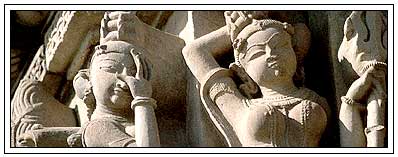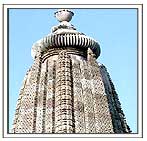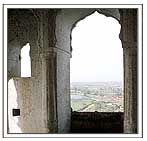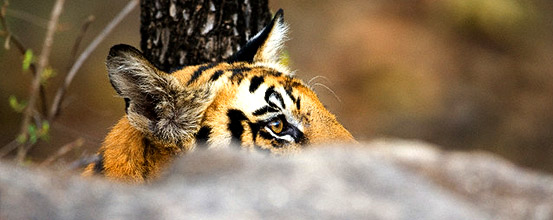It is really one of the most fortuitous accidents of history that Khajuraho
lies where it does – well away from the path taken by the fanatical hordes
that periodically unleashed their destructive wrath on the towns and villages
of medieval India. The amazing temples built here by the Chandela Rajput rulers
during the 10th to 12th centuries, were thus spared the destruction and mutilation
suffered by countless other temples throughout north and central India.

Khajuraho has grown into a major tourist destination from the obscure village
it was. The temple town lies on the northern fringe of the state and served
by an airport where loads of tourists arrive to see the magnificent temples.
Of the 85 temples that were originally built, only 22 remain but just these
put Khajuraho right up there, top of the list of India’s must visit destinations
such as Delhi, Jaipur, Khajuraho and Varanasi.
History
Most of the temples at Khajuraho were built in a short span of about a
hundred years, between 950 and 1050 AD. The Chandela dynasty claimed its descent
from a Brahmin priest’s daughter, Hemvati, who is said to have fallen
in love with Chandra, the moon-god, while bathing in a secluded pool. The
child of this union, Chandravarman, founded the dynasty. Inscriptions found
near the temples show that Harshadeva ruled in the early 10th century, and
was followed by Yasovarman, Dhanga and Vidyadhara. As each of them expanded
the Chandela kingdom, they also made additions to the temple complex.
At the height of their empire, the Chandelas ruled over almost the entire
present-day Madhya Pradesh. The first Muslim invasions of India came during
the reign of Vidyadhara. A turbulent period followed during which the Chandelas
moved to hill forts to defend their kingdom against Muslim attacks. Their
rule eventually ended in the 14th century. And the temple complex at Khajuraho,
created in a remote, heavily forested area, remained forgotten till 1838 when
it was re-discovered by Captain T.S. Burt of the Asiatic Society.
What to see
Temples here epitomize the northern medieval style of Indian architecture.
Twenty of the original 85 are still standing in this extra-ordinary group
of temples. These are examples of a fully developed expertise and craftsmanship,
the coincidence of a religious need, great patronage and artistic genius.The
sculpture at Kajuraho is of very high technical quality. This is particularly
apparent in the representation of the female figure.The celestial beauties
who are the musicians and entertainers of the reconstructed heaven which the
temple represents are shown in a wide range of provocative attitudes. Yet
there is an air of lightness appropriate for creatures who, according to legend,
were made of mist and vapour.
Western Group of Temples
The Western group is certainly the best known, because it is to this group
that the largest and most typical Khajuraho temple belongs: The Kandariya
Mahadev.
ChitraguptaTemple
A three- headed image of Brahma is enshrined in this temple. The approach
is equally impressive, with lions flanking the northern and elephants the
southern steps that lead up to it. A Nandi bull faces the shrine.

Kandariya Mahadeo
The largest, most typical Khajuraho temple, it soars 31 m high. Dedicated
to shiva, the sanctum sanctorum enshrines a lingam. The main shrine is exquisitely
carved and features, in delicate detail, gods, goddesses, celestial maidens
and lovers. Particularly noteworthy are the
entrance arch, the ceilings and pillars of the interior compartments.
Chaunsat Yogini
The only granite temple and the earliest surviving shrine of the group (900
A.D.), it is dedicated to Kali. Only 35 of the original 65 shrines remain.
Another Kali temple (originally dedicated to Vishnu) is the Devi Jagdambe
Temple.
LakshamanaTemple
The lintel over the entrance of this beautiful Vaishnavite temple shows the
trinity of Brahma, Vishnu and Shiva with Lakshmi, Vishnu's idol of Vishnu's
incarnations, Narasimha and Varaha. This boar incarnation also appears in
a nine-foot high statue at the Varaha Temple.
MatangeswaraTemple
Still a living place of worship, the temple is dedicated to shiva, has an
eight feet high lingam, and is outside the precincts of the Western Group.
Eastern Group of Temples
AdinathTemple
Dedicated to the Jain saint, Adinath, the temple is lavishly embellished with
sculpted figures, including yakshis. The three Hindu temples of the group
are the Brahma, containing a four faced lingam, the Vamana, which is adorned
on its outer walls with carving of apsaras in a variety of sensuous attitudes;
and the javari, with a richly-carved gateway and exterior sculptures.
Eastern Group of Temples
AdinathTemple
Dedicated to the Jain saint, Adinath, the temple is lavishly embellished with
sculpted figures, including yakshis. The three Hindu temples of the group
are the Brahma, containing a four faced lingam, the Vamana, which is adorned
on its outer walls with carving of apsaras in a variety of sensuous attitudes;
and the javari, with a richly-carved gateway and exterior sculptures.
ParsvanthTemple
The group's largest Jain temple and exquisite in detail. The sculptures on
the northern outer wall are particularly noteworthy. The themes depict, in
charming detail, everyday activity. Within, a throne faces the bull emblem
of the first tirhankara, Adinath. The Parsvanath image was installed in 1860.

GhantaiTemple
This Jain temple has a frieze which depicts the 16 dreams of Mahavira's mother,
and a jain goddess on a winged Garuda.
Southern Group of Temple
DulahDeoTemple
This finest temple at Khajuraho also called Kunwar Math offers some of the
choicest sculptures especially the Shalbhanjika. It is a fully developed temple
measuring 21 m by 12 m (69 ft. by 40 ft.) with the ardhamanadap, the mandapa,
the maha mandapa, the antarala and the garbha griha with no circumambulatory
passage. The ceiling of the maha mandap is a series of diminishing circles
of overlapping stones. There is an image of Shiva on the lintel of the entrance
to the garbh griha indicating that the temple was originally dedicated to
Lord Shiva.
Getaways
PannaNational Park (32 kms)
Complementing the man made perfection of the Khajurahotemples, is the dramatic
scenic splendour of Panna National Park. A mere 30-minute drive away from
Khajuraho and extending over 543 km, spread along the banks of the River Ken,
the park's topography is a magnificent one of deep gorges, tranquil valley
and dense teak forests.
During the monsoons, the park is a lush green haven with cascading waterfalls.
The park's area includes the former shooting reserves of the erstwhile royal
state of Panna and Chhattarpur and the jungles today harbour many species
of wildlife. The tiger can be glimpsed here, along with other rare species
such as the Leopard, Wolf and Gharial. Most likely, it will be here if the
Caracal, a vanishing cousin of the extinct Cheetah, is ever sighted.
Herds of Blue Bulls, Chinkaras and Sambars are a common sight. The wild boar,
the Sloth Bear, the Cheetal, the Chowsingha, the Indian Fox, the Porcupine,
and a host of lesser fauna are also seen.
A separate sanctuary for Gharial Ken Gharial Sanctuary has been set up for
Indian crocodiles. The park can probably boast of the highest density of the
Paradise Fly-Catchers. This rich avian and faunal life combined with its picturesque
scenery make a visit to the Park a memorable one.
Orchha Tourism
Orchha the medieval city has exquisite palaces and temple built by Bundela
rulers in the 16th and 17th centuries that have retained much of their pristine
perfection.
Jehangir Mahal is an exquisite tiered palace crowned by graceful chhatries.
From here the view of soaring Laxminarayan temple spires and cenotaphs is
spectacular. Complementing the noble proportions of their exteriors are interiors
which represent the finest flowering of the Bundela school of painting. Vibrant
murals encompassing a variety of religious and secular themes bring the walls
and ceiling to rich life.
Strewn around the area are little shrines and memorials, each with its own
poignant history, each contributing to the beauty of Orchha.
Kalinjar Fort
100km from Khajuraho
Kalinjar, a historical fort situated in Banda district (Uttar Pradesh) , is
a precious monument of the art and science of fortification and a gem of archeology
built during the end of 1st and beginning of 2nd millennium.
The sand stone/ granite fort is built on strong 25-30 meter wide foundation,
having height of 30-35 meter with 8 meter wide summit spread all around with
length of 7.5 km over the hillock. Much before fortification this place was
considered to be one of the most revered places of devotional and meditational
penance and has been cited in Vedas, Epics like Mahabharata and Ramayana,
Buddha and Jain literatures. Kalinjar is popular also for the folk songs of
Bundelkhand.
Gangau Dam
Gangau dam is at a distance of 34 kms from Khajuraho, a natural dam at the
confluence of the Ken and Simri rivers, ideal for nature-lovers, anglers and
the adventure minded. The dam is surrounded by the Panna National Park &
Gangau Sanctuary.
PandavFalls
It is at 34 kms from Khajuraho, a picturesque waterfall in a bowl shaped valley
on the ken river. The Pandavas are said to have spent a part of their exile
here.
Majhganwa Diamond Mines, Panna
56 kms from Khajuraho, are the only diamond mines of Asia. Open from 9 am
to 1 pm. Sunday Closed.
DhubelaMuseum
57 km. Located on the bank of a lake, the museum houses a wide variety of
Shakti Cult sculptures. There are different sections on garments, weapons
and paintings.
Ajaygarh Fort
80 kms from Khajuraho, is at a height of 688 meters above sea level and was
capital of the Chandelas during their decline.
Dining Out
Raja Caféstrong: Raja's Cafe, built around a tree right in the
city centre. It is run by a Swiss lady who settled down here long back. Serves
Indian and continental cuisine. Swiss rosti is its specialty.
Mediterranean: Run by an Italian lady serves Mexican and Italian food.
Safari : Serves Indian, continental, Israeli and Korean cuisines.
Food and Fun : Serves Continental, Chinese and Italian dishes.
Lovely restaurant : Serves wholesome Vegetarian thali
Shopping
Folk and tribal artifacts are the main attractions of Khajuraho. Hand-crafted
figurines in wood, brass, iron, terracotta and stone, paintings on cloth and
paper and tribal jewellery are available at stores in Gole Market. Bargaining
is a norm here. There are some stalls selling handicrafts near the Eastern
Group as well.
Market timings: 10 am to 8 pm.
Mrignayani is a handicraft showroom run by Madhya Pradesh state government.
Open: 10am to 8 pm. Closed on Tuesday.
A weekly bazaar is held at Rajinagar on Tuesdays, 5 km from Khajuraho. The
market is worth a visit to buy silver goods and brassware.
Visiting
Travellers to Khajuraho can come over any time between July and March,
a period at the end of the monsoon season and just before the hot summer months.
The best time would be when it’s balmy and cool in the early winter months
of October/November.
Tourist Offices
There are two good tourist offices in Khajuraho, one run by the Government
of India’s Department of Tourism, the other by the MPTDC. The offices
are located close to the western group of temples close to the town.
Government of India Tourist Office, Opposite the Western Group of Temples,
Khajuraho - 471606. Tel: 2047
Regional Office, Madhya Pradesh State Tourism Development Corporation Ltd.,
Tourist Bungalow Complex, Khajuraho - 471606. Tel: 2051
How to get there
Air
Khajuraho has an airport primarily catering to the thousands of visitors that
fly in to see the temples. The town is airlinked to Bhopal, Gwalior, Indore,
Delhi, Varanasi and Khajuraho by regular commercial services. From the airport
to the actual town of Khajuraho, catch a tourist coach, bus or taxi.
Rail
The nearest railhead for Khajuraho is off the main line, 100 km away and
handles only slow passenger and good trains, so entraining it to Khajuraho
isn’t a convenient option. Jhansi is a more convenient railhead (172
km) if you are travelling from Delhi or Chennai; Satna (117 km, on the Mumbai-Allahabad
line) is the most suitable if you are travelling from Mumbai, Calcutta or
Varanasi. At both these railway stations, connecting trains may or may not
be available the same day, so hire a private taxi or try the local roadways
buses.
Road
Private cabs and taxis, cars, coachs run by tour operators and the state roadways
buses are the options if you are travelling to Khajuraho by road. Regular
buses run to and from Jhansi, Satna, Harpalpur (94 km) and Mahoba (61 km).









